SAN FRANCISCO - Iterative reconstruction helps tremendously when it comes to CT scanning, according to the experience of one U.K. facility. However, the real advancement in reconstruction is model-based iterative reconstruction (MBIR), which reduces dose to levels that could alter the way CT is used in the future.
Dr. Carl Roobottom from the Peninsula Radiology Academy in the U.K. presented his findings during the International Society for Computed Tomography (ISCT) meeting on Monday. During the same session, other presenters echoed Roobottom's sentiments regarding MBIR.
There are three types of reconstruction: filtered back projection (FBP), iterative reconstruction (IR), and MBIR. FBP has been a mainstay in the imaging community since the 1970s and makes computation simple, but also makes geometric assumptions, such as focusing on a particular point. In addition, FBP creates a noisy image.
The answer to a noisy image has been to turn the current up. "I suggest it's a little bit like having an old radio that you can't hear because of crackly noise, so you have to turn the volume up," Roobottom said. "The trouble with turning the volume up is the fact that because this is an inverse relationship, the less and less noise we want, the more and more tube current we have to give."
Iterative reconstruction on the other hand is insensitive to noise. And it produces images with incomplete datasets and also raw data. The data may also be postmanipulated so data can be blended afterward, Roobottom said. The problem is slice-based IR works through filtered back projection so it still has the inherent problems with FBP.
Model-based iterative reconstruction doesn't use FBP. It doesn't make any assumptions about the physics of the object, so it looks at the size of the focal spot, the voxel is a cubic voxel, and MBIR models all the different components of the imaging shape to reduce noise, he said.
"If we follow the analogy of the radio, FBP is like your old radio with noise. Slice-based or noise-based IR is like the good analog radio, and MBIR is more like you're DAB [digital auto broadcasting] radio or a good old British hi-fi," he said.
At the Peninsula Radiology Academy, clinicians used slice-based data and introduced a dose reduction by 40% across all their scans. There was very little difference in image quality compared with FBP. IR was used when images were inherently noisy. That means the technique was predominantly used with high-definition CT scanning of patients with a high body mass index.
Model-based iterative reconstruction is the same as adaptive statistical iterative reconstruction (ASIR) but provides dose reduction and resolution improvements. MBIR has the potential to move the goal post in a number of areas. For instance CT with MBIR can move into plain film doses, he said.
Other ISCT presenters shared Roobottom's enthusiasm for model-based iterative reconstruction.
Dr. Dominik Fleischmann from Stanford University in California said MBIR creates substantial improvement in image quality equating to the same or better image quality as FBP and IR, with at least 30% less dose.
Dr. Jeffrey Mendel, an assistant professor at Tufts University in Boston wonders why physicians are still using filtered back projection in the first place. After all, 1976, the year FBP was invented, is also the same year Microsoft was first trademarked, he noted.



















